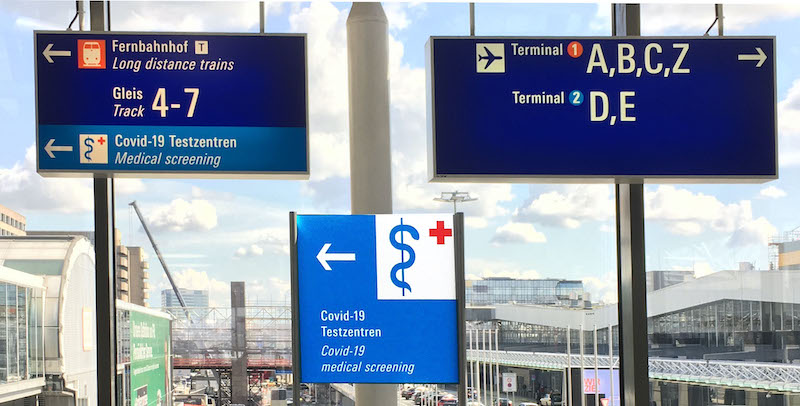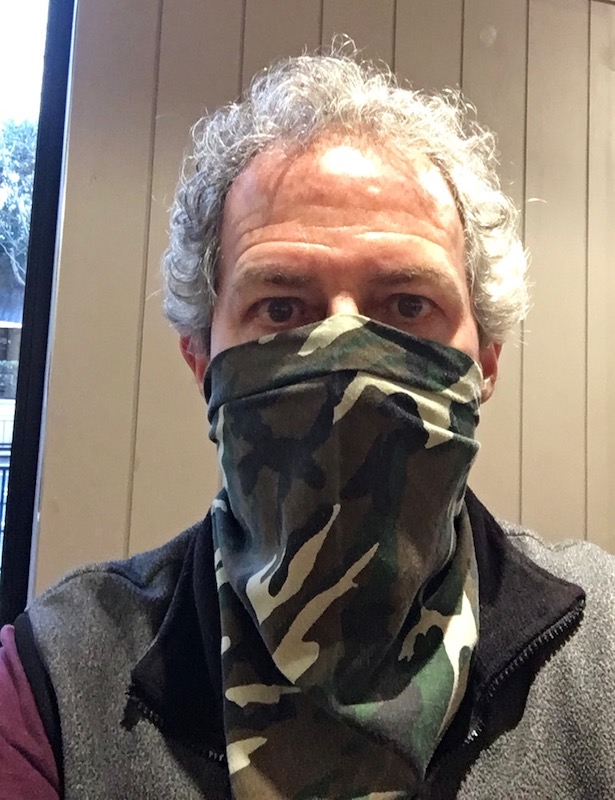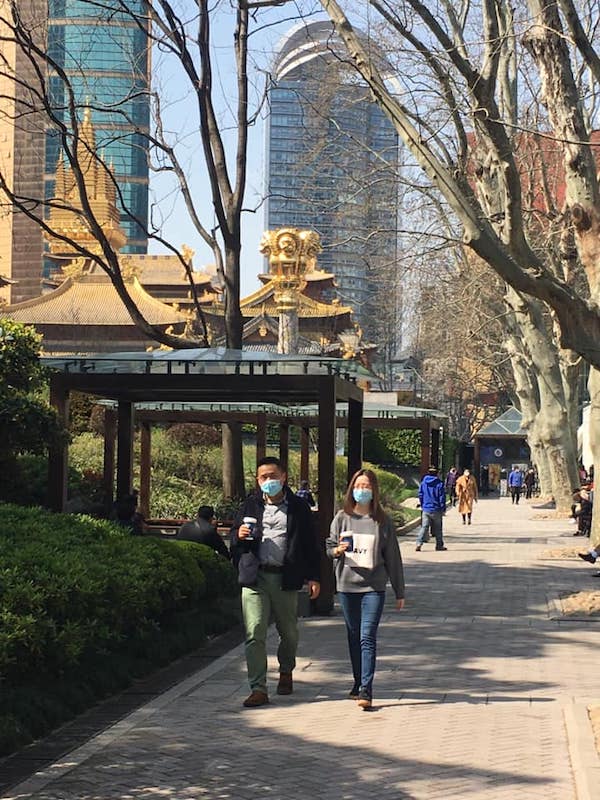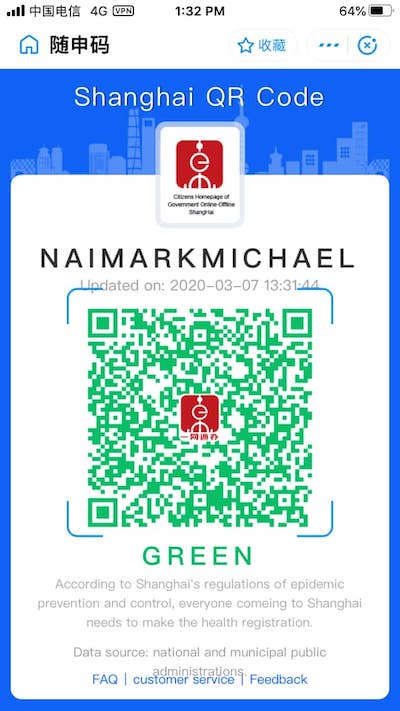Shanghai Updates 2020
(from Facebook posts)
Michael Naimark
Sep 3 ·

It’s all about testing.
Yesterday afternoon, the pre-screening line at the gate for the Frankfurt - Shanghai flight formed early, over an hour before boarding. I already knew that because it was my second attempt in two days for the flight. This time, the young airline attendant profusely thanked me for having my passport already opened to the new visa page in the back. She bordered on gushing, it was too much, and it could only be read as a symptom of stress and exhaustion. An hour later as I boarded the flight, she was fumbling to put her day bag in the compartment under her kiosk. I whispered “slow down, hang in there” as I passed, and she flashed me a faint smile.
My return to Shanghai from a quick trip to San Francisco went perfectly, almost. Late last week, the Chinese Consulate in NYC issued my near-impossible-to-get China visa and the next day I had my return ticket for Monday. Flights back to China were also near-impossible to get: Kayak was advertising one-way tickets from SF to Shanghai for “as low as” $8,922. My ticket, procured by my master flight-hacking nephew, was considerably less but required long layovers in Vancouver and Frankfurt. On Monday, I flew from San Francisco through Vancouver to Frankfurt and made it all the way to the boarding gate for Shanghai, where I was busted for not having the proper new covid form. I had the old covid form, properly issued to me just hours earlier.
The reason for my trip was to accompany Marie Sester for overdue eye surgery. With a success rate of 90%, we decided on surgery at UCSF, with its world class opthamology center, and with whatever help I could provide to tick up the odds. Surgery went well. Then I needed to get back to Shanghai ASAP for a more than double-time fall semester with an almost-tripled student population.
Over 200 of my NYU Shanghai colleagues also needed to get back to Shanghai, many of whom went to the US for the December holidays and were still there. NYU managed to negotiate special China visas for everyone, months in the making, and not unrelated to current geopolitics. (As a latecomer, my visa was aided by a rockstar diplomat friend.) We were all lucky and grateful, and many are right now in the process of returning.
Grounded in Frankfurt Monday, I was stuck in the international zone unable to set foot on German soil because, airline agents repeated, of my US citizenship. The next available flight was in two days, on Wednesday, but I would need to straighten out my covid tests and new form. If not, I was firmly told, I would have to fly back to Canada or the US. There are no covid testing facilities inside the airport but there is one 5 minutes away outside.
The Frankfurt airport was d-e-a-d. Except for a couple concourses, most everything was closed and the hallways were empty. I stayed overnight Monday in the one hotel inside, with its tiny overpriced rooms. On Tuesday, a helpful airline agent phoned Immigrations for me and was told that the US citizen ban on entering Germany was untrue. So by mid-day, I was out on German soil and getting my third covid test and new form.
The first two covid tests, in San Francisco Saturday, were a 15 minute “rapid test,” which turned out to be useless for Chinese visa clearance, and a nucleic test, advertised as having a 1-2 day turnaround but which took 4 days. This third covid test, in a bustling temporary facility just outside the Frankfurt airport, was advertised as having a 6 hour turnaround but which took 18 hours.
These delayed test results in SF and Frankfurt were presumably due to the rapidly increasing demand, part of which, at least for travel, were also due to rules changing daily. “Changing hourly,” one airline agent told me. Their frustration and exhaustion were obvious and often emotional. In San Francisco, frustration and exhaustion were also obvious among both longtime friends and random encounters.
But you already knew that. (Incidentally, what I learned about packing for travel to a pandemic zone: you basically need one pair sweatpants, one pair shorts, some t-shirts, and underwear since you won’t be going out on the town.)
I get the dumbshit American resistance to wearing masks (remember I’m from Michigan), and that the American capitalist infrastructure cannot usefully track everyones' movements via smartphone. But for the life of me, I cannot comprehend how low my country has sunk into the cesspool of ignorance. Hello? Science. Feedback. The importance of data. Downplaying covid testing is heinous, irresponsible, and hypocritical, especially from those at the top who get tested every day.
+++++
May 19 ·
“VR Confinement Sketches.” Nine 30-second narratives made from photogrammetry scans of personal spaces by NYU Shanghai international students. 3D 360 YouTube, best viewed with VR headsets or mobile YouTube app. https://www.youtube.com/watch?v=NG9RquEIP7k

+++++
May 10 ·
Shanghai is almost entirely reopened. Next week Shanghai Disneyland opens for the first time since January. Temperature scanning at malls is becoming sporadic and people seem to be loosening a little from 100% mask wearing. Curious observation: DIY masks never caught on here, perhaps because it didn’t need to. Everyone wears only standard issue masks, even with a huge percentage of young people with fashionable hairstyles, eyeglasses, and clothing.
Last week NYU Shanghai opened to all students, staff, and faculty. It was a soft opening beginning in February with 24 hour advance notice, dean’s approval, and surgical visits to an eery empty building. Now, everyone must walk over a red disinfection carpet, show their green “Shanghai QR Code” on their mobile, and pass through an automatic temperature scanner before entering. Inside, everyone wears masks in public, hand disinfectants are everywhere, and all classrooms, meeting rooms, labs, and eating spaces have been reconfigured for one person per table.
NYU leadership tells us that we’ve been "challenged to serve as a model of responsible reopening.” We may be the most privileged university in China in terms of academic freedom, something we discuss openly, and this is a responsibility that we don’t want to fuck up.
I’m originally from Michigan. I get it. I grew up with the dumbshit protesters with guns in Lansing. It’s very, very difficult to convey what’s happening in the US to my Chinese colleagues. Even a British doctor friend here doesn’t get it. Best we can muster is that Easterners and Westerners have different senses of self, Westerners as “independent” “minded” and Easterners with a more collective perspective. This was long before Xi or Trump. Now we hear about a US Republican strategy memo advising candidates "Don’t defend Trump – attack China.” What to do?
It’s good to be physically back with friends and colleagues. Even with talking through masks, standing just a little further apart in conversation, no hugging, and sparse seating, it feels more transitionary than a new normal.
[Image: NYU Shanghai, May 8]

+++++
April 5 ·
When I mentioned to my Western-savvy TCM doctor (who’s actually Indonesian) that there’s a mask shortage in the US, she looked confused and I tried explaining to her why. There was a mask shortage here in Shanghai early on, but still, everyone outside was wearing masks. She was also confused that there's no temperature scanning at every - every - store and residential entry (aim at wrist or forehead, takes one second). Also, when President Xi says “stay home,” everybody stays home, and when he says wash your hands,” everybody washes their hands.
You’re all fucked. Unless there’s a huge groundswell from the bottom up to control things. IMHO totally possible.
+++++
April 5 ·
Why do you think?
Why do wealthy areas of L.A. have high rates of coronavirus cases?
+++++
April 4 ·
Anyone know why COVID tests are one-bit “positive" or “negative”? Isn’t there gradation and doesn’t that matter? The only reference I’ve seen, early on, was about a pet dog in Hong Kong testing “weakly positive.” Isn’t this hugely important as the world debates the efficacy of DIY face masks?
https://www.ktsm.com/local/dogs-cats-cant-pass-on-coronavirus-but-can-test-positive/
+++++
March 31 ·
At the onset of COVID here in Shanghai, I was without a mask and used a bandana instead. Everyone here has masks and, though it’s not illegal, you cannot enter a store or supermarket without one. In the US it appears opposite: wearing masks in public is perceived as depriving medical staff of them. My routine has been mask on, usually no gloves, touch shopping carts, touch fruits and vegetables, make sure nobody coughs on me, go home, and wash the fuck out of my hands and whatever I bring in. For me, the main purpose of a mask is to prevent airborne spray and touching my face. The bandana was pretty good, and as my Western-savvy TCM doctor confirmed today, absolutely better than nothing.
Here are more details:
What Are The Best Materials for Makinng DIY Masks?
https://smartairfilters.com/en/blog/best-materials-make-diy-face-mask-virus/
My Western-savvy TCM doctor also asked me to pass this on to my US and other friends, apparently just out: Covid-19 handbook https://covid-19.alibabacloud.com/ .
[Image: Shanghai, January 27]

+++++
March 17 ·
Two months. It’s been two months here in Shanghai living with uncharted measures much of the world called draconian (though we were never technically on “lockdown”). The first two weeks were scariest, fueled by uncertainty. Yesterday the parks and gyms were open. Hang. In. There.
[Image: Jing’An Temple Park today]

+++++
March 7 ·
Dear World, Get used to it.

+++++
Shanghai update: Yesterday, in an NYU Shanghai faculty meeting (online, 94 people), leadership said that though data from Hubei may be uncertain, their Shanghai data is accurate and that coronavirus “peaked” two weeks ago with around 450 cases and is now around 150. Still walking and biking daily, I’m not surprised: when the Chinese government declares People’s War, there’s no dissent. Everyone wears a mask. All commercial establishments and apartment compounds have temperature checks and are constantly being cleaned. And I have no doubt that all comrades wash their hands several times a day (instructions are everywhere).
China’s grid-style social management, a pyramid with Xi at the top and neighborhoods broken down into 100 square meter cells, is both efficient for top-down directives and a disaster for critical information working its way from the bottom up, which led to so much tragedy in Hubei. My NYU Shanghai colleagues and I are plugged in to the activist social media community here (and yes we say it!), and I’ve interacted with several of my neighborhood cell party members, who are always kind and sincere.
Shanghai is still far from normal. Many public places - parks, museums, libraries, many restaurants, schools - are still closed. Curiously, most all of the giant malls with the Calvin Kleins, Huaweis, and Uniqlos, and supermarkets in the lower floor, are entirely open and largely (except for the supermarkets) empty of shoppers. Contrary to the US press, every Starbucks I’ve seen is open, as well as a surprising number of other coffee places. Groceries and supermarkets remain well-stocked and busy. Masks have become readily available.
It’s hard to gauge the numbers, but an incredible amount of people are simply staying home. There is no “lockdown” (a word CNN used at least once regarding Shanghai). Many people are working from home. Home internet here is mostly optical and high speed. I’ve had no problems with video meetings or classes.
My VR/AR Fundamentals class met yesterday for its second weekly three-hour session, with 11 students and our TA. The students are in Shanghai (3), elsewhere in China (4), and Vancouver, Texas, NYC, and London. (Remember, January was both Chinese New Year and NYU Shanghai’s off-month: well over half our students and faculty, who come from all over the world, were away when the virus hit.) The class went well, with a lot of presentation material and video, and with everyone up and on (we use Zoom). Our Interactive Media Arts group is comparing notes on our unique online challenges and collecting anecdotes, which so far are interesting enough that we’ll likely publish something.
Assuming the worst is over in Shanghai (yes, iffy), it’s now an incredible perch to watch the wave radiate across the globe. Yes, hugely needed vigilance. Shamelessly irresponsible, culturally insensitive, media sensationalism (they do know better, but hey, it’s business!). And the most revealing will be government action: the big guys are all now on the hot seat.
Good.
[Image: Untended plants on the promenade of the five-storey, five-block River Mall last Sunday (with dozens of shops and restaurants below open), in the shadow of the China Art Museum (closed).]

+++++
February 4 ·
Shanghai update: I’m fine, everyone I know is fine, everyone on the street appears fine (and in masks), and the streets are mostly empty. Last week’s Lunar New Year holiday was extended into this week to encourage staying in. Supermarkets and neighborhood food shops are well-stocked, except masks. I’ve been going out daily on foot and bike (with a mask) to survey. People seem unfazed. I’ve been fever-scanned several times before entering shops and was visited at home by two officials with a clipboard (who knew my name) and asked if I had left Shanghai recently. “No.” “OK.” “Bye.”
The NYU Shanghai campus is closed - we’re all working from home - and will open two weeks late (Feb 17) with an extraordinary experiment: All classes, for 1,600 students spread out over 19 majors, will be taught entirely online. Since January was our off-month, many students and faculty are away (and as of last Friday, told to stay away). Many are in NYC, and NYU has 13 smaller campuses around the world (another extraordinary experiment). Our group, Interactive Media Arts, may have the most challenging classes to go online (e.g., I teach VR/AR, others teach robotics, digital sculpting, and talking fabrics) but we’re also the most experienced in, well, interactive media. So we have our work cut out for us.
There’s obviously still a lot of unknowns, but the coronavirus story that’s emerging is that the government’s yen for secrecy and top-down control made a huge tragic mess early on. The facts were known but the people who knew them either spoke up and were ignored and sometimes punished, or they were fearful of their boss and complied with the party line. (Sound familiar?!?)
The most accurate and up-to-date map (from John Hopkins) is https://www.arcgis.com/apps/opsdashboard/index.html#/bda7594740fd40299423467b48e9ecf6 .
We’re all watching pensively.
[photos: from https://radiichina.com/coronavirus-confinement/ ]

+++++
|